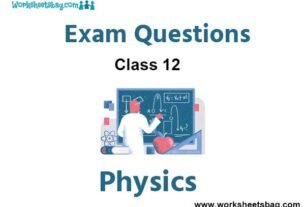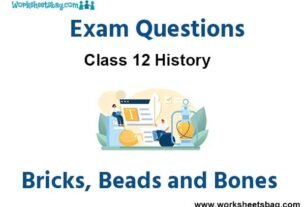Please see Introduction to Micro Economics Exam Questions Class 12 Economics below. These important questions with solutions have been prepared based on the latest examination guidelines and syllabus issued by CBSE, NCERT, and KVS. We have provided Class 12 Economics Questions and answers for all chapters in your NCERT Book for Class 12 Economics. These solved problems for Introduction to Micro Economics in Class 12 Economics will help you to score more marks in upcoming examinations.
Exam Questions Introduction to Micro Economics Class 12 Economics
MCQs
Question. Which of the following is a statement of normative nature in economics?
(a) Economics is study of choices/alternatives.
(b) Government should be concerned with how to reduce unemployment
(c) According to an estimate, in spite of severe shortage, more than 10% of houses in Indian cities are lying vacant.
(d) Accommodation of Refugees is posing a big problem for the Europe
Answer
A
Question. A growth of resources in an economy is shown on PP by:
(a) Leftward Shift
(b) Unchanged PPC
(c) Rightward Shift
(d) None of the above
Answer
C
Question. The basic assumption regarding resources while drawing a PPC is
a) Resources are unlimited
b) Resources depend on the kind of goods produced
c) Resources can be put to a particular use
d) Resources are constant and given
Answer
D
Question. In a centrally planned economy, the central problems are solved by
a) Supply of goods
b) Demand for goods
c) Market mechanism
d) Planning authority
Answer
D
Question. The study of jute industry is a macroeconomic study. This statement is
a) Conditional
b) True
c) Can’t say
d) False
Answer
D
Very Short Answer Type Questions
Question. What is meant by economising of resources?
Answer : It means making best use of available resources.
Question. Give two examples each of micro and macroeconomics.
Answer : Micro economics examples are individual demand and individual supply Macroeconomics examples are aggregate demand and aggregate supply.
Question. Define marginal rate of transformation.
Answer : MRT is the ratio of units of one good sacrificed to produce one more unit of other goods. MRT = Δy / Δx
Short Answer Type Questions
Question. Does massive unemployment shift the PPC to the left?
Answer : Massive unemployment will shift the PPC to the left because labour force remains underutilized. The economy will produce inside the PPC indicating underutilization of resources.
Question. What does the problem for whom to produce refer to?
Answer : This is essentially the problem of distribution of income between the different groups of the society. This problem has limited resources. Because of scarcity, city of resources, producers are unable to produce everything in desired quantity. But they will have to make a choice as to which one is important as a whole, so that limited resources can be rationally managed.
Question. Why is a Production Possibility Curve (PPC) concave? Explain.
Answer : Production possibility curve is concave to the origin because marginal opportunity cost of the shifting resources from commodity B to commodity A tends to rise. Marginal opportunity cost tends to rise because the factors of production are not perfect substitute to each other. So when one factor is shifted from the production of one good to another, then its productivity falls, thus causing marginal opportunity cost to rise.
Long Answer Type Questions
Question. Draw a production possibility curve and mark the following situations.
1. Underutilization of resources
2. Full employment of resources
3. Growth of resources
Answer : Every point on PP curve like ABCDEF indicates full employment and efficient uses of resources. Any point below or inside PP curve like G underutilization of resources. Any point above PP curves like H indicates growth of resources.

Production possibility curve and opportunity cost:-
It refers to a curve which shows the various production possibilities that can be produced with given resources and technology.


If the economy devotes all its resources to the production of commodity B, it can produce 15 units but then the production of commodity A will be 0. There can be a number of production possibilities of commodity A & B.
If we want to produce more commodity B, we have to reduce the output of commodity A & vice versa.
Shape of PP curve and marginal opportunity cost:-
1. PP curve is a downward sloping curve – In a full employment economy, more of one goods can be obtained only by giving up the production of other goods. It is not possible to increase the production of both of them with the available resources.
2. The shape of the PP curve is concave to the origin – The opportunity cost for a commodity is the amount of other commodity that has been foregone in order to produce the first.
The marginal opportunity cost of a particular good along the PPC is defined as the amount sacrificed of the other good per unit increase in the production of the good in question.
For example: suppose a physiotherapist having a private clinic in Mumbai is earning 7 lakhs annually. There are two other alternatives for her.
1. Joining a government run hospital in Hyderabad earning Rs. 6 lakhs annually.
2. Opening a clinic in her home town in Nagpur and earning 4 lakhs annually.
The opportunity cost will be joining government hospital in Hyderabad, thus increasing marginal opportunity cost implies that PPC is concave.

Question. Explain the central problem of the choice of products to be produced.
Answer : Production, distribution and disposition of goods and services are the basic economic activities of life. These problems are called central problems because these are the most basic problems of an economy and all other problems revolve around them. Allocation of resources refers to the problem of assigning the scarce resources in such a manner so that maximum wants of the society are fulfilled. As resources are limited in relation to the unlimited wants, it is important to economize their use and utilize them in the most efficient manner.
In nutshell, an economy has to allocate its resources and choose from different potential bundles of goods (What to produce), select from different techniques of production (How to produce), and decide in the end, who will consume the goods (For whom to produce).

